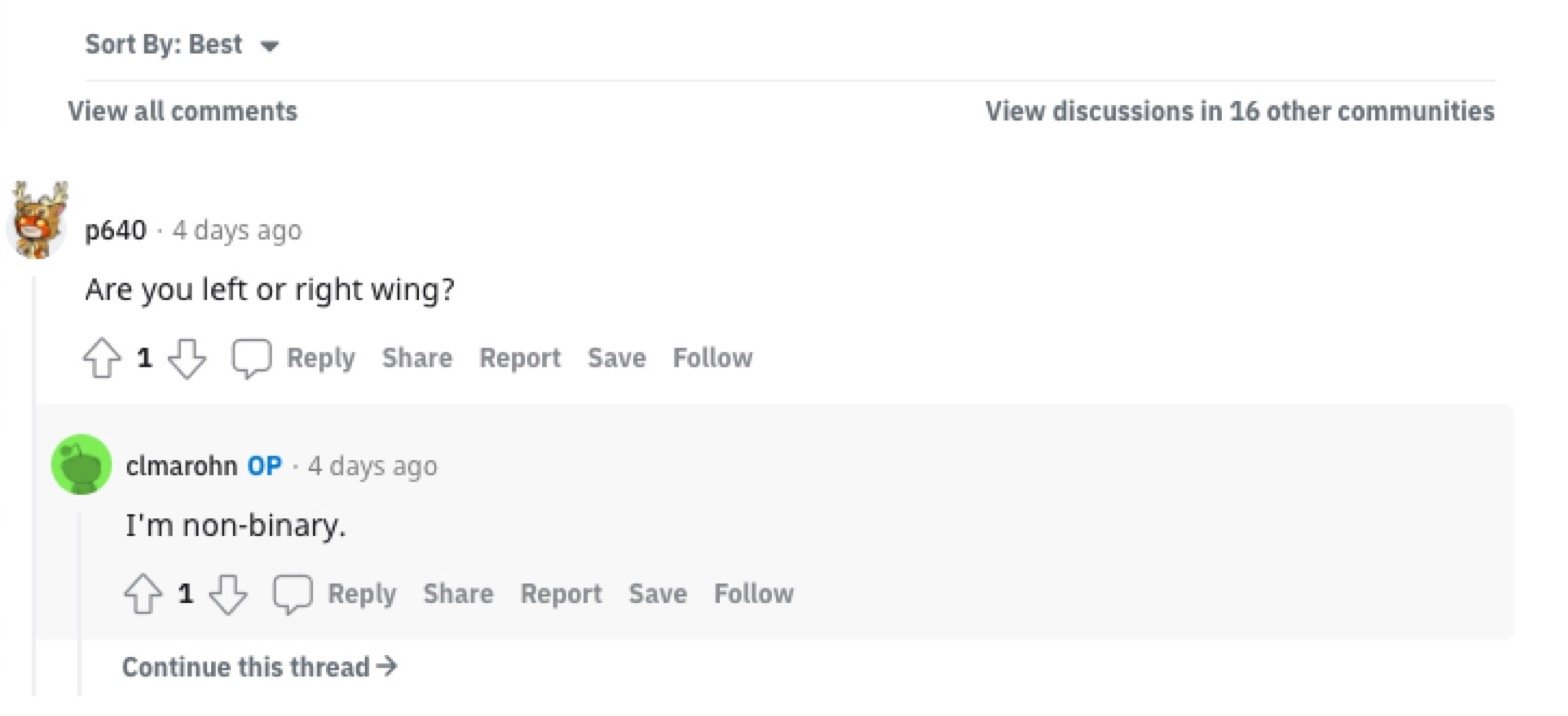Q: Are You a Democrat or Republican? A: I'm Non-Binary.
To Our Readers: We at Strong Towns honor the achievements of Dr. Martin Luther King, Jr., the Baptist minister and civil rights leader who advocated for nonviolent resistance against racial segregation. In solidarity with essential workers (including service, retail, first responder, and entertainment/media employees), we are following our normal publishing schedule. We hope this content finds you well and in your fullest possible celebration and recognition of Dr. King’s contributions.
(Source: Unsplash.)
Until last week, I thought AMA stood for “against medical advice.” If you shared my understanding, let me introduce you to the AMA subreddit (aka /IAmA), an immensely popular online forum with the same acronym that drove thousands of new readers to the Strong Towns website last week.
The free-for-all, unmoderated forum is where famous and compelling characters from Barack Obama to Bill Gates to Joan Jett to the late Anthony Bourdain present themselves (with no security detail) to Reddit’s millions of users and say “Ask Me Anything.” Strong Towns President Charles Marohn took the hot seat last week.
The AMA questions inspire myriad secondary threads, comments, and opportunities to “upvote” (or downvote) all the above. Over the course of eight hours in a two-day span, Marohn and Strong Towns staffers fielded the lion’s share of 817 questions.
Nothing was off limits, including asking which American political party Marohn aligns with, an issue irrelevant to the non-partisan mission of Strong Towns and Marohn—who gave a provocative and cheeky answer to the question.
Marohn opened the session by declaring “I’m the founder of Strong Towns, a national nonpartisan nonprofit trying to save cites from financial ruin.” The questions came fast and furious from a lot of places we know and love, and also from many new points of view.
(Source: Reddit.)
One place that drove a lot of traffic—so to speak—in the direction of the AMA was the YouTube channel Not Just Bikes (NJB). NJB fans were the source for many Strong Towns AMA comments, including one from a user who hopes to see more collaboration between the organizations, such as the series NJB produced on the Strong Towns approach.
One participant, screen-named humerusbones, wanted to know if the Strong Towns movement, which reaches an audience of two million people per year, will reach a “tipping point,” after which “it will be possible to have a bigger impact, or simply be a bigger part of the national conversation?”
Strong Towns wants to build a movement of a million people who care enough to tell someone else about the organization, Marohn said, “if we reach that level of interest, there won't be a city in the U.S. making a financial decision where our thoughts and ideas don't influence the conversation…if we're not at this goal already, we're really close.”
Jacobs4525 told Marohn they wanted to know what strategies Strong Towns has for convincing people that ideas like upzoning, mixed-use zoning, and reduced parking minimums will work, “...since I feel like I’m talking to a brick wall when I mention that I don’t like not being able to walk to places that are close by and really should be accessible by foot, for example.”
Strong Towns worked hard at the beginning to change minds, but in the past six-plus years the goal has been to go where people are already asking for change, Marohn wrote. “I don’t need (anymore) to convince the skeptical as much as explain to the curious.”
“The people we see doing the best work today are people who do more listening than speaking, avoid getting bogged down or defined by national political discourse, and just relentless[ly] do what they can accomplish and use that to build momentum. I wish I had a magic way to change someone's mind today, but the reality is that it is a long game.”
(Source: Reddit/Gates Notes.)
Also present in the give and take was Strong Towns Community Builder John Pattison, who explained “something else we've found, u/Jacobs4525, is that many towns and cities don't want to be the first to do something. They want to be able to point to other towns and cities that have tried a reform -- for example, ending parking minimums -- and it has worked out for them.”
To that end, Pattison said, Strong Towns has started compiling case studies and examples around core topics and linking them in its Action Lab, where these examples can be used to persuade wary policymakers and neighbors to try a Strong Towns approach on for size.
Tncivil2 asked for recommendations for how others in the engineering profession can use their talents and knowledge to make things better and educate others.
“Let me start with one thing not to do: DON'T FIGHT EVERY FIGHT,” Marohn advised. “So many people want to die on the hill for what they think is right, but don't do it. We need good people … respectfully raising these issues and making them part of the conversation. We need to create more room for more people to enter into the dialogue and you can be a voice for that.”
Marohn said he learned a lot from a Strong Towns board member (and good friend) who was a city council member and advised people to know what they want to accomplish and look for opportunities to “assert a call for those changes, all the while building relationships that will help…”
Representatives from small cities struggling with population declines—at risk for completely vanishing—sought advice in the AMA.
(Source: Twitter.)
“Small town decline is a really difficult topic,” Marohn commiserated. “I'm on record as saying that most (over half) of our small towns are likely to go away over the next generation because they have become too financially fragile to survive, and have given themselves no real reason to exist (beyond inertia). That being said, I wrote a plan last year for resource-based communities to do just that, but it is really a good fit for all small towns and their economic development approach.”
Ohiogood chimed in about the core metro areas of larger cities such as Cleveleand, Columbus, or Cincinnati. Strong Towns ideas, they said, apply well to streetcar neighborhoods and annexed suburbs, but how can the organization’s principles help the old centers of cities with more than 2,000,000 people?
These places need to evolve over time, fill in empty or unproductive places, and be scaled to humans, Marohn said. “There is a lot more opportunity in those three cities to take a humble approach—work on the next smallest increment of development—and see the value of food trucks, pocket parks, pop-up bike lanes, because those downtowns, unlike NYC, have wide areas that have been denuded of their tax base.”
“You all have been very generous and asked some great questions,” Marohn wrote at the end of the discussion feed. “Strong Towns is an ongoing conversation. We’re working to address a complex set of challenges. I welcome you to plug in, regardless of your starting point.”





Jay Stange is an experienced community development consultant, journalist, grassroots organizer, musician, teacher, and off-grid project manager. Raised in Alaska, his passions include transforming transportation systems and making it easier to live closer to where we work, play, and do our daily rounds. Find him shopping for groceries on his cargo bike, gardening, and coaching soccer in West Hartford, Connecticut, where he lives with his family. You can connect with him on Twitter at @corvidity.